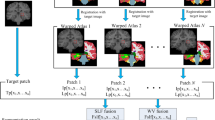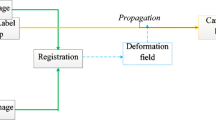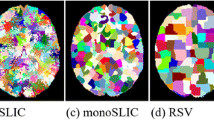Abstract
Multi-atlas based segmentation (MAS) methods have demonstrated superior performance in the field of automatic image segmentation, and label fusion is an important part of MAS methods. In this paper, we propose a sparse representation label fusion (SRLF) method combining pixel grayscale weight. We adopt a strategy for solving sparse coefficients multiple times and introduce pixel grayscale weight information in the label fusion process. In order to verify the segmentation performance, we apply the proposed method to segment subcutaneous tissues in 3D brain MR images of the challenging publicly available IBSR datasets. The results show that our method effectively improves the defects of SRLF method and achieves higher segmentation accuracy. We also compared our methods with commonly used automatic segmentation tools and state-of-the-art methods, and the average Dice similarity coefficient (Dsc) of the subcutaneous tissues obtained by our method was significantly higher than that of the automatic segmentation tools and state-of-the-art methods.
Access this chapter
Tax calculation will be finalised at checkout
Purchases are for personal use only
Similar content being viewed by others
References
Fischl, B.: Freesurfer. Neuroimage 62(2), 774–781 (2012)
Patenaude, B., Smith, S.M., Kennedy, D.N., Jenkinson, M.: A Bayesian model of shape and appearance for subcortical brain segmentation. NeuroImage 56(3), 907–922 (2011)
Sandra, G., et al.: A review on brain structures segmentation in magnetic resonance imaging. Artif. Intell. Med. 73, 45–69 (2016)
Wang, M., Li, P.: A review of deformation models in medical image registration. J. Med. Biol. Eng. 39(1), 1–17 (2018)
Collins, D.L., Pruessner, J.C.: Towards accurate, automatic segmentation of the hippocampus and amygdala from MRI by augmenting ANIMAL with a template library and label fusion. NeuroImage 52(4), 1355–1366 (2010)
Isgum, I., et al.: Multi-atlas-based segmentation with local decision fusion-application to cardiac and aortic segmentation in CT scans. IEEE Trans. Med. Imaging 28(7), 1000–1010 (2009)
Sabuncu, M.R., et al.: A generative model for image segmentation based on label fusion. IEEE Trans. Med. Imaging 29(10), 1714–1729 (2010)
Nie, J., Shen, D.: Automated segmentation of mouse brain images using multi-atlas multi-ROI deformation and label fusion. Neuroinformatics 11(1), 35–45 (2013)
Lin, X.B., Li, X.X., Guo, D.M.: Registration error and intensity similarity based label fusion for segmentation. IRBM 40(2), 78–85 (2019)
Sanroma, G., et al.: A transversal approach for patch-based label fusion via matrix completion. Med. Image Anal. 24(1), 135–148 (2015)
Rousseau, F., Habas, P.A., Studholme, C.: A supervised patch-based approach for human brain labeling. IEEE Trans. Med. Imaging 30(10), 1852–1862 (2011)
Bai, W., et al.: Multi-atlas segmentation with augmented features for cardiac MR images. Med. Image Anal. 19(1), 98–109 (2015)
Roy, S., et al.: Subject-specific sparse dictionary learning for atlas-based brain MRI segmentation. IEEE J. Biomed. Health Inform. 19(5), 1598–1609 (2015)
Tong, Y., et al.: Segmentation of MR images via discriminative dictionary learning and sparse coding: application to hippocampus labeling. NeuroImage 76(1), 11–23 (2013)
Lee, J., Kim, S.J., Chen, R., Herskovits, E.H.: Brain tumor image segmentation using kernel dictionary learning. In: Proceedings of 37th Annual International Conference, pp. 658–661. IEEE EMBC, Milan (2015)
Liu, Y., Wei, Y., Wang, C.: Subcortical brain segmentation based on atlas registration and linearized kernel sparse representative classifier. IEEE Access 7, 31547–31557 (2019)
Zikic, D., Glocker, B., Criminisi, A.: Encoding atlases by randomized classification forests for efficient multi-atlas label propagation. Med. Image Anal. 18(9), 1262–1273 (2014)
Moeskops, P., et al.: Automatic segmentation of MR brain images with a convolutional neural network. IEEE Trans. Med. Imaging 35(5), 1252–1261 (2016)
Kaisar, K., et al.: Automated sub-cortical brain structure segmentation combining spatial and deep convolutional features. Med. Image Anal. 48, 177–186 (2018)
IBSR Homepage. https://www.nitrc.org/projects/ibsr. Accessed 6 Nov 2019
SuperElastix Homepage. https://github.com/SuperElastix/. Accessed 6 Nov 2019
Author information
Authors and Affiliations
Corresponding author
Editor information
Editors and Affiliations
Rights and permissions
Copyright information
© 2020 Springer Nature Singapore Pte Ltd.
About this paper
Cite this paper
Li, P., Wang, M. (2020). Sparse Representation Label Fusion Method Combining Pixel Grayscale Weight for Brain MR Segmentation. In: Su, R., Liu, H. (eds) Medical Imaging and Computer-Aided Diagnosis. MICAD 2020. Lecture Notes in Electrical Engineering, vol 633. Springer, Singapore. https://doi.org/10.1007/978-981-15-5199-4_2
Download citation
DOI: https://doi.org/10.1007/978-981-15-5199-4_2
Published:
Publisher Name: Springer, Singapore
Print ISBN: 978-981-15-5198-7
Online ISBN: 978-981-15-5199-4
eBook Packages: EngineeringEngineering (R0)




